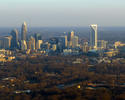As the San Francisco Bay Area (combined statistical area, or CSA, as defined by the Office of Management and Budget) has sprawled into the San Joaquin Valley, all population growth has been in the three Valley metros for two years (Map above). This article describes population trends over the last 10 years in the CSA, which includes the six tidewater (adjacent to the ocean or the Bay) metropolitan areas, traditionally thought of as the Bay Area, including core San Francisco and San Jose as well as Santa Rosa, Napa, Vallejo and Santa Cruz. read more »
Demographics
The Rust Belt Aesthetic
Overseas competition. Automation replacing industrial labor. The inability to adapt to the global economy. Unions. Even the weather. Many reasons are given for why Rust Belt cities have lagged the rest of the nation in their recovery from their industrial heyday. But there’s one under-recognized but still consequential reason – the poor quality of the Rust Belt aesthetic. Rust Belt cities have never quite been known for their looks, and in an era when looks increasingly matter, they often fall short. read more »
- Login to post comments
Red States Need to Be Citizen Friendly
My latest column is now online in Governing magazine. It’s a very tough look at northern red state governments and how they have not delivered economic results. I specifically mention Kansas and Indiana. read more »
- Login to post comments
A Very Curious Thing is Happening in Austin, Texas
When the nation’s CEOs were being polled about state business climates earlier this year for Chief Executive’s annual rankings of the “Best and Worst States for Business,” there was a lot of concern about Austin, Texas, among the magazine’s conservative-leaning readership. read more »
- Login to post comments
America’s Post-Pandemic Geography
Even as vaccination increases across the United States and an end to the tragedy of the Covid-19 pandemic seems in sight, the economic, fiscal, political, and geographic fallout from the virus cannot be overstated: a massive public health crisis that left more than half a million Americans dead, an economic catastrophe that caused record unemployment and small-business closures, and a seismic political event that surely helped tip the presidential election. The pandemic will pass, and the economy will revive, as it is already doing. read more »
- Login to post comments
America's Dispersing Metros: The 2020 Population Estimates
The big story among the nation’s major metropolitan areas (the now 51 of 55 over one million with more than one county) over the past decade has been the persistence of urban core out-migration and suburban in-migration.
The Nearly 5,000,000 Suburban Net Domestic Migration Advantage read more »
- Login to post comments
The Idaho Boom
Idaho has recently been the fastest growing state in the country, with population growth of 2.1% last year. Of course it is easy to get high percentages on a small base, but the Idaho growth story is real. From 2018 to 2019, the most recent available data, Coeur d’Alene ranked 7th among all metro areas in population growth, Boise ranked 8th, and Idaho Falls ranked 18th. read more »
Yeomanry's Global Decline
For much of the last part of the 20th Century, the world’s middle class was ascendant, expanding and, in most countries, firmly in control of national politics and culture. Yet in more recent decades, this process has been slowly reversed, in the United States as well as in Europe and, increasingly, East Asia. read more »
- Login to post comments
What Happened in the 2020 Election? An Interactive Exploration of the Outcomes
We search for prima facie evidence of vote-count irregularities in the 2020 presidential election, by the very simple device of looking for anomalous patterns in the vote counts at the county level. read more »
- Login to post comments
Could COVID Exodus Speed the Heartland Revival?
Over the past two decades America’s largest urban areas enjoyed a heady renaissance, driven in large part by the in-migration of immigrants, minorities and young people. But even as a big-city dominated press corps continued to report on gentrification and displacement, those trends began to reverse themselves in recent years as all three of those populations started heading in ever larger numbers to suburbs, sprawling sunbelt boomtowns and smaller cities and out of the biggest ones. read more »






















